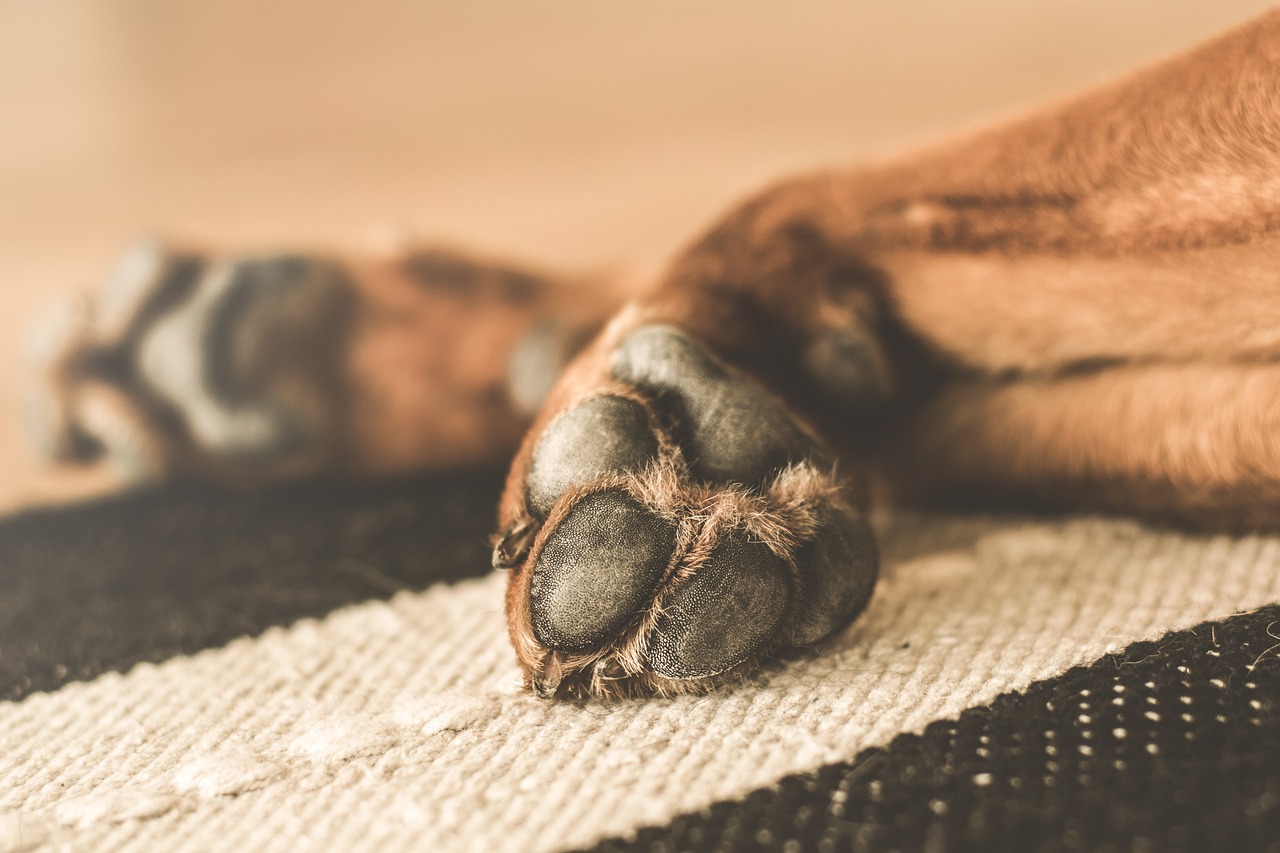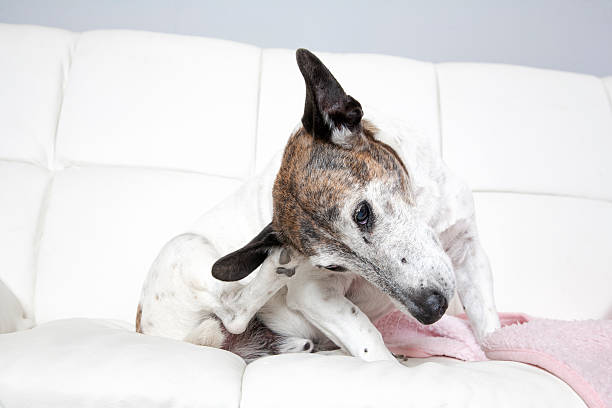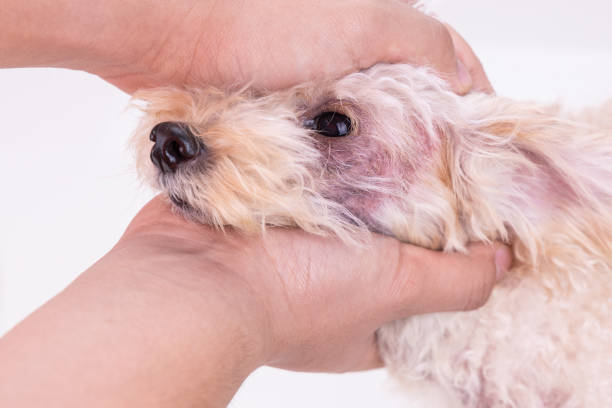A variety of injuries and conditions, including cuts, scrapes, burns, and frostbite, can afflict dogs’ paws. Dog pads help maintain paw health, which can vary in size and thickness. Some dog breeds may possess denser pads than others, or a higher quantity of paw pads.
The main function of the paw pad is to protect the foot from injury. Understanding the various risks and taking steps to protect your pet’s feet is important.
How Do Dog Paws Become Injured
Dogs’ paws can get injured in a variety of ways. Sometimes, the injury is obvious, with blood streaming down the dog’s leg. Other times, the injury is hidden and may only be detected if the dog starts limping or licking its paw excessively. Here’s how your dogs can get injured paws:
- Stepping on broken glass during dog walks
- Getting caught in traps
- Getting hit by cars
- Eating harmful objects
- Dog licks their paws excessively
If you think your dog’s feet are injured, taking it to the vet for a check-up is important. The vet will examine the dog’s paw and take an x-ray to determine any damage to the bones or joints. If there is damage, the vet will prescribe treatment, including antibiotics, pain medication, or surgery.
Common Dog Paw Injuries


Paw Injury Due to Debris
One of the most common ways dogs injure their paws is by stepping on something sharp, such as glass or metal. If you see your dog step on something sharp, carefully inspect its paws for any cuts or punctures. If you find any cuts, clean them with hydrogen peroxide or Betadine solution and apply an antibiotic ointment.
If the cut is more than a quarter-inch deep, takes longer than 10 minutes to stop bleeding, or if you suspect a fracture, immediately take your dog to the veterinarian.
You may also read: My Dog Has a Swollen Paw – What Should I Do?
Paw Burns
Outdoor dogs are often stepping on hot surfaces. They may not realize if they get burned until the area swells or bleeds. Signs of a burn include swelling, redness, and temperature changes in the affected area. If you suspect your dog has a burn, immediately take them to the veterinarian.
Bite Wound
Another common injury is a bite wound. Dogs are curious creatures and may not realize how painful a bite can be until it’s too late. If you suspect your dog’s feet have been bitten, immediately take them to the veterinarian.
Necessary Items for Dog Paw Care
Keeping the canine paws healthy and safe is important by taking simple precautions and using the right products. Here are some necessary items for dog paw care:
Paw Balm
A good paw balm will protect your dog’s paws from the elements and help heal any cuts or wounds of cracked paws. Look for a balm that contains natural ingredients like beeswax, shea butter, or coconut oil. You can make your dog paw balm by mixing some ingredients: beeswax, shea butter, coconut oil, olive oil, and essential oils.
Paw Wax
Paw wax is a great way to protect your dog’s paws from salt and snow in the wintertime. It creates a barrier between the snow and your dog’s skin, preventing snowballs from forming between his toes.
Dog Paw Care Tools
A few dog paw care tools on the market can help make taking care of your pup’s paws a breeze. One popular tool is the paw plunger, a small, handheld device that helps remove dirt and debris from your dog’s paws. It has a soft, silicone cup on one end that suctions onto the paw and a small brush on the other to help loosen dirt and debris.
Brushes come in various shapes and sizes, but the most important factor is that they have soft bristles to avoid hurting your dog’s delicate paws.
Paw Wipes


It’s a great way to clean your dog’s paws after a walk in the snow or just a muddy day at the park. Many dog owners use them to wipe away dirt and mud accumulated between their dog’s toes.
Dog Boots for Snow
Many dog owners use these booties to protect their paws in the snow. Depending on your dog’s size, they come in various sizes and lengths.
Dog Mittens
Dog mittens are a great way to keep your dog’s paws warm in the winter or when walking on icy surfaces.
How to Keep Your Dog’s Paws Clean
Here are some tips on how to clean your dog’s paws:
- Wash your dog’s paws regularly, especially after they’ve been outside. This will help remove any dirt, mud, or other debris that can cause irritation or infection.
- If your dog has a lot of hair between its toes, you may want to trim it short to make it easier to clean its paws.
- Use warm water and a gentle soap bar when washing your dog’s paws. Avoid harsh chemicals or detergents, which can harm your dog’s skin.
- Gently rub each paw between your hands to remove any dirt or debris.
- Never scrub your dog’s paws. This will cause unnecessary pain and discomfort.
- When drying your dog’s paws, gently pat them dry with a soft towel or hand towel.
- Keep their paws dry and clean to avoid bacterial growth.
- Never use a hairdryer to dry your dog’s paws.
- Keep the dog’s nails trimmed. When clipping the dog’s nails, it is best not to cut them too short. Always use dog nail trimmers that are specifically for dogs only.
How to Prevent Injuries to Your Dog’s Paws
To prevent injuries to your dog’s paws, you should avoid walking your dog on hot pavement or asphalt. The heat can cause burns on your dog’s paws. You can check the pavement temperature by placing the back of your hand on the surface; if it is too hot for you to hold your hand there for five seconds, it is too hot for your dog’s paws.
You should also avoid letting your dog walk on frozen surfaces, as they can suffer from frostbite. Ensure adequate traction when walking your dog on ice or snow; you can make your dog wear booties or a non-skid spray to provide traction.
If you are taking your dog outdoors, you should also wear proper footwear made for walking on uneven surfaces. You can ensure your dog does not slip and slide by applying the appropriate traction aids to the area where they walk.
Checking for Injuries or Irritations
It’s important to be aware of the signs and symptoms of something wrong. If your dog is excessively licking or biting at its paws and your dog’s feet smell, there may be something wrong. Check for cuts, abrasions, thorns, or other foreign objects that may have gotten lodged in between the toes or pads.
Clean the wound with warm water and mild soap if you see any injury. Apply an antibiotic ointment and cover the wound with a bandage if available.
If your dog seems in pain when he walks or stands, or if his paws are swollen, take him to the veterinarian immediately. There may be an infection or other injury that requires treatment. In extreme cases, surgery may be necessary.
How to Treat Your Dog’s Injured Paws
Treating your dog’s injured paws properly is important, as they can be quite susceptible to cuts, scrapes, and other injuries. Your dog must see a veterinarian immediately if it has a broken paw.
You may also follow this guide:
- Clean the wound and check for any debris or objects lodged.
- Apply pressure if the wound is bleeding.
- Apply a cold compress to the wound if it is swollen or bruised.
- Take the dog to a veterinarian if the injury is severe.
When to see a vet immediately
If your dog has been injured and is limping, you should take him to the veterinarian for examination as soon as possible.
Your dog’s paw may be swollen, but this is not always a sign of an infection. If you see your dog’s paw bleeding, but the cut does not appear to be infected, you should take them to the veterinarian for an examination.
If your dog has an injured paw, it is important to ensure it is not serious. If you notice any signs of infection, such as redness and swelling of the paw, you should immediately take your dog to a veterinarian for an examination.
In the End
You can do a few things to help keep your dog’s paws healthy and safe. Check their paws regularly for cuts, sores, or ingrown nails, and moisturize them if necessary. When outside, always make sure they wear paw protection, such as boots or wax. Lastly, be careful when choosing what products to clean your floors and carpets, as some can be harmful if your dog ingests them.



